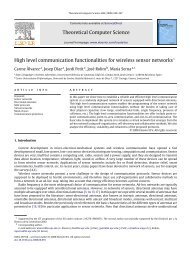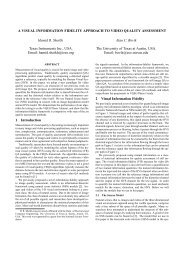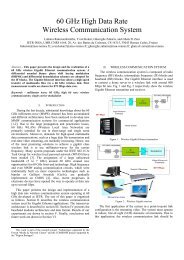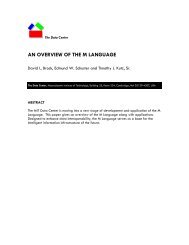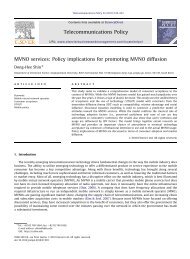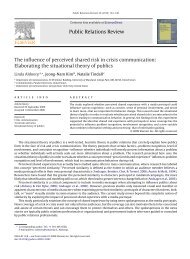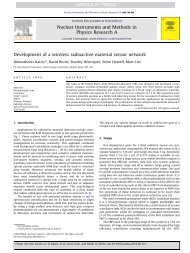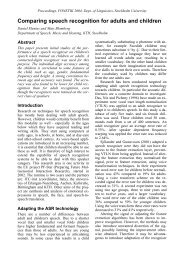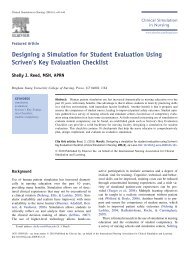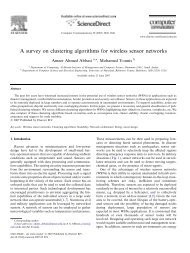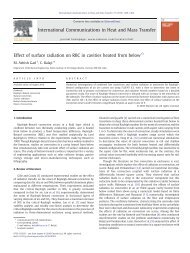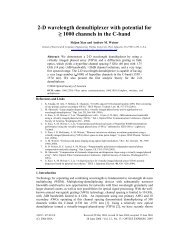Word level precision of the NALIGN automatic segmen- tation ...
Word level precision of the NALIGN automatic segmen- tation ...
Word level precision of the NALIGN automatic segmen- tation ...
Create successful ePaper yourself
Turn your PDF publications into a flip-book with our unique Google optimized e-Paper software.
Proceedings, FONETIK 2004, Dept. <strong>of</strong> Linguistics, Stockholm University<br />
<strong>Word</strong> <strong>level</strong> <strong>precision</strong> <strong>of</strong> <strong>the</strong> <strong>NALIGN</strong> <strong>automatic</strong> <strong>segmen</strong><strong>tation</strong><br />
algorithm<br />
Kåre Sjölander and Mattias Heldner<br />
Centre for Speech Technology (CTT), KTH, Stockholm<br />
Abstract<br />
This work presents an evaluation <strong>of</strong> <strong>the</strong> word<br />
<strong>level</strong> <strong>precision</strong> <strong>of</strong> an <strong>automatic</strong> <strong>segmen</strong><strong>tation</strong><br />
algorithm, <strong>NALIGN</strong>. Measurements <strong>of</strong> <strong>the</strong> portion<br />
<strong>of</strong> temporal overlap between <strong>automatic</strong> and<br />
manual word <strong>level</strong> <strong>segmen</strong><strong>tation</strong>s show that a<br />
<strong>precision</strong> <strong>of</strong> 90 to 95% can be achieved, partly<br />
depending on <strong>the</strong> type <strong>of</strong> speech material. These<br />
<strong>precision</strong> figures are fur<strong>the</strong>rmore only marginally<br />
lower than <strong>the</strong> gold standard obtained comparing<br />
independent manual <strong>segmen</strong><strong>tation</strong>s.<br />
Introduction<br />
Automatic alignment <strong>of</strong> speech and written represen<strong>tation</strong>s<br />
<strong>of</strong> <strong>the</strong> spoken material; or put differently<br />
<strong>automatic</strong> <strong>segmen</strong><strong>tation</strong> <strong>of</strong> speech; enables<br />
speech researchers to do extensive quantitative<br />
studies that would have been very time<br />
consuming and expensive o<strong>the</strong>rwise. However,<br />
a prerequisite for using <strong>automatic</strong> <strong>segmen</strong><strong>tation</strong>s<br />
in quantitative research is that <strong>the</strong> quality <strong>of</strong> <strong>the</strong><br />
<strong>segmen</strong><strong>tation</strong> is known. The researcher needs to<br />
know <strong>the</strong> agreement to be expected between<br />
<strong>automatic</strong> and manual <strong>segmen</strong><strong>tation</strong>s, if <strong>the</strong>re<br />
are systematic errors affecting <strong>the</strong> outcome <strong>of</strong><br />
<strong>the</strong> investigation, etc.<br />
This work presents an evaluation <strong>of</strong> <strong>the</strong><br />
quality <strong>of</strong> <strong>the</strong> word-<strong>level</strong> <strong>segmen</strong><strong>tation</strong> <strong>of</strong> an<br />
<strong>automatic</strong> <strong>segmen</strong><strong>tation</strong> algorithm, <strong>NALIGN</strong>.<br />
The evaluation includes <strong>the</strong> <strong>precision</strong> <strong>of</strong> <strong>the</strong><br />
aligner, measured as <strong>the</strong> portion <strong>of</strong> temporal<br />
overlap between <strong>automatic</strong> and manual <strong>segmen</strong><strong>tation</strong>s,<br />
as well as qualitative analyses <strong>of</strong> systematic<br />
errors.<br />
Method<br />
Speech material<br />
Speech material collected within <strong>the</strong> GROG<br />
project (e.g. Carlson et al., 2002; Heldner &<br />
Megyesi, 2003) representing two different<br />
speaking styles, a read-aloud monologue and a<br />
spontaneous dialogue 1 was used in this evaluation.<br />
The read-aloud monologue data consists <strong>of</strong><br />
a rendering <strong>of</strong> a children’s book by a male pr<strong>of</strong>essional<br />
reader at a publisher <strong>of</strong> talking books.<br />
The recording is 17 minutes long and contains<br />
about 2700 words. The spontaneous dialogue<br />
material is made up <strong>of</strong> a radio broadcast, where<br />
a well-known female Swedish politician is interviewed<br />
by one male and one female interviewer.<br />
The interview lasts 25 minutes and contains<br />
approximately 4100 words.<br />
Automatic <strong>segmen</strong><strong>tation</strong><br />
The <strong>automatic</strong> <strong>segmen</strong><strong>tation</strong> <strong>of</strong> <strong>the</strong> speech material<br />
was achieved by means <strong>of</strong> <strong>NALIGN</strong>, an<br />
alignment algorithm developed at CTT by <strong>the</strong><br />
first author (e.g. Sjölander, 2003). <strong>NALIGN</strong><br />
uses a Hidden Markov Model based method to<br />
generate word and phoneme <strong>level</strong> transcriptions<br />
from a verbatim orthographic transcription and<br />
a sound file. As speech contains various nonword<br />
phenomena with temporal extent, such as<br />
pauses, breaths and sighs, <strong>the</strong> aligner also inserts<br />
symbols for silences between words<br />
where needed. O<strong>the</strong>r important features are that<br />
<strong>NALIGN</strong> can handle long sound files (> 1 h);<br />
and that processing time is proportional to <strong>the</strong><br />
length <strong>of</strong> <strong>the</strong> sound file.<br />
Manual <strong>segmen</strong><strong>tation</strong><br />
To establish a reference for <strong>the</strong> <strong>automatic</strong> <strong>segmen</strong><strong>tation</strong>,<br />
as well as a gold standard for <strong>the</strong><br />
alignment <strong>precision</strong> (see below), <strong>the</strong> authors independently<br />
<strong>segmen</strong>ted <strong>the</strong> entire speech material.<br />
The manual <strong>segmen</strong><strong>tation</strong> was guided primarily<br />
by auditory perceptual criteria. Each<br />
word (as <strong>segmen</strong>ted by <strong>NALIGN</strong>) was presented<br />
in isolation, and <strong>the</strong> word boundaries<br />
were adjusted so that <strong>the</strong> audible traces <strong>of</strong> preceding<br />
or following words were minimized.<br />
Alignment <strong>precision</strong><br />
The alignment <strong>precision</strong> was measured as <strong>the</strong><br />
portion <strong>of</strong> temporal overlap between <strong>the</strong> <strong>automatic</strong><br />
<strong>segmen</strong><strong>tation</strong> and <strong>the</strong> manual <strong>segmen</strong><strong>tation</strong>s.<br />
The <strong>precision</strong> was estimated on a frameby-frame<br />
basis (every 10 th ms) including <strong>the</strong> silences<br />
inserted by <strong>the</strong> aligner, as well as on a<br />
word-by-word basis excluding those silences.<br />
The measurement <strong>of</strong> <strong>the</strong> portion <strong>of</strong> temporal<br />
overlap is illustrated in Figure 1.
Proceedings, FONETIK 2004, Dept. <strong>of</strong> Linguistics, Stockholm University<br />
Figure 1. Illustration <strong>of</strong> <strong>the</strong> measurements <strong>of</strong> temporal overlap. The three label tiers beneath <strong>the</strong> waveform<br />
contain <strong>the</strong> manual <strong>segmen</strong><strong>tation</strong> (top); <strong>the</strong> output <strong>of</strong> <strong>the</strong> aligner (middle); and overlapping and<br />
non-overlapping portions (bottom). Non-overlapping portions are marked in dark grey.<br />
The frame-by-frame overlap was measured<br />
as <strong>the</strong> duration <strong>of</strong> overlapping frames divided<br />
by <strong>the</strong> duration <strong>of</strong> all frames, including overlaps<br />
in silent portions (such as <strong>the</strong> overlap in <br />
in Figure 1).<br />
The second measure, <strong>the</strong> word-by-word<br />
overlap, was used for more detailed analyses <strong>of</strong><br />
words with different properties. The word-byword<br />
overlap was measured as <strong>the</strong> duration <strong>of</strong><br />
overlap in <strong>the</strong> words, divided by <strong>the</strong> duration <strong>of</strong><br />
all words in <strong>the</strong> manual <strong>segmen</strong><strong>tation</strong>. That is,<br />
overlaps in silent portions (e.g. <strong>the</strong> overlap in<br />
in Figure 1) were excluded from <strong>the</strong><br />
numerator as well as from <strong>the</strong> denominator.<br />
A gold standard for <strong>the</strong> alignment <strong>precision</strong><br />
was established by measuring <strong>the</strong> frame-byframe<br />
overlap between <strong>the</strong> manual <strong>segmen</strong><strong>tation</strong>s<br />
by <strong>the</strong> first and second authors.<br />
Results<br />
The results <strong>of</strong> <strong>the</strong> measurements <strong>of</strong> alignment<br />
<strong>precision</strong> using <strong>the</strong> frame-by-frame measure are<br />
shown in Table 1 toge<strong>the</strong>r with <strong>the</strong> gold standard<br />
<strong>of</strong> overlap between manual <strong>segmen</strong><strong>tation</strong>s.<br />
These figures show that <strong>the</strong> overall <strong>precision</strong><br />
<strong>of</strong> <strong>the</strong> <strong>automatic</strong> <strong>segmen</strong><strong>tation</strong> was fairly<br />
high. The temporal overlap between <strong>automatic</strong><br />
and manual <strong>segmen</strong><strong>tation</strong> was 90 to 95% depending<br />
on <strong>the</strong> type <strong>of</strong> speech material and <strong>the</strong><br />
human transcriber. That is, <strong>the</strong> <strong>precision</strong> was<br />
lower in <strong>the</strong> spontaneous dialogue than in <strong>the</strong><br />
read-aloud monologue. Moreover, <strong>the</strong> alignment<br />
<strong>precision</strong> was only marginally lower than <strong>the</strong><br />
gold standard.<br />
Table 1. The alignment <strong>precision</strong> in <strong>the</strong> readaloud<br />
monologue and spontaneous dialogue<br />
data measured using <strong>the</strong> frame-by-frame measure<br />
<strong>of</strong> overlap. The rows labeled <strong>NALIGN</strong> vs 1 st<br />
and 2 nd auth show <strong>the</strong> alignment <strong>precision</strong> relative<br />
to <strong>the</strong> manual <strong>segmen</strong><strong>tation</strong>s by <strong>the</strong> first and<br />
second authors. Gold standard is <strong>the</strong> overlap<br />
between <strong>the</strong> manual <strong>segmen</strong><strong>tation</strong>s.<br />
Read-aloud Spontaneous<br />
monologue dialogue<br />
<strong>NALIGN</strong> vs 1 st auth 95.9% 93.4%<br />
<strong>NALIGN</strong> vs 2 nd auth 95.4% 90.4%<br />
Gold standard 96.6% 94.9%<br />
Error analysis<br />
Qualitative examination <strong>of</strong> <strong>the</strong> discrepancies between<br />
manual and <strong>automatic</strong> <strong>segmen</strong><strong>tation</strong>s revealed<br />
that <strong>the</strong>re were several recurring types <strong>of</strong><br />
errors related to <strong>the</strong> silences inserted by <strong>the</strong><br />
aligner. There were several cases where <strong>the</strong><br />
aligner underestimated <strong>the</strong> duration <strong>of</strong> words<br />
preceding a silence, and consequently overestimated<br />
<strong>the</strong> duration <strong>of</strong> <strong>the</strong> following silence (as<br />
in <strong>the</strong> word ‘försvann’ in Figure 1). There were<br />
also a number <strong>of</strong> inaccuracies involving erroneous<br />
insertions <strong>of</strong> silences. These errors occurred<br />
in <strong>the</strong> beginning or in <strong>the</strong> end <strong>of</strong> words, during<br />
voiceless stops or during portions with creaky<br />
voice. Thus, <strong>the</strong> aligner also underestimated <strong>the</strong><br />
duration <strong>of</strong> words with stops or creaky voice at<br />
<strong>the</strong> word edges. There were also a few cases<br />
where word labels were wrongly placed relative<br />
to silences, typically a word placed before<br />
where it ought to have been after <strong>the</strong> silence.
Proceedings, FONETIK 2004, Dept. <strong>of</strong> Linguistics, Stockholm University<br />
Finally, <strong>the</strong> overall impression given by <strong>the</strong><br />
error analysis was that words adjacent to a silence<br />
represent <strong>the</strong> worst cases with respect to<br />
alignment <strong>precision</strong>.<br />
<strong>Word</strong>s adjacent to silences<br />
The silences inserted by <strong>the</strong> aligner thus account<br />
for several recurring error types. Fur<strong>the</strong>rmore,<br />
<strong>the</strong>se silences are frequent. About<br />
32% <strong>of</strong> <strong>the</strong> words in <strong>the</strong> read-aloud monologue<br />
and 38% <strong>of</strong> <strong>the</strong> words in <strong>the</strong> spontaneous dialogue<br />
are ei<strong>the</strong>r preceded, followed or both preceded<br />
and followed by silences. To assess <strong>the</strong><br />
influence <strong>of</strong> silences, <strong>the</strong> <strong>precision</strong> (here using<br />
<strong>the</strong> word-by-word overlap between <strong>the</strong> aligner<br />
and <strong>the</strong> manual <strong>segmen</strong><strong>tation</strong> by <strong>the</strong> second<br />
author) was measured separately for words<br />
preceded and followed by silences in <strong>the</strong> <strong>automatic</strong><br />
<strong>segmen</strong><strong>tation</strong>, and for words nei<strong>the</strong>r preceded<br />
nor followed by silences. These results<br />
are shown in Table 2.<br />
Table 2. The <strong>precision</strong> (using <strong>the</strong> word-by-word<br />
overlap) in words preceded or followed by silences,<br />
and in words nei<strong>the</strong>r preceded nor followed<br />
by silences, in <strong>the</strong> read-aloud monologue<br />
and spontaneous dialogue data.<br />
Read-aloud Spontaneous<br />
monologue dialogue<br />
Silence before 91.4% 87.3%<br />
Silence after 92.4% 85.3%<br />
No adjacent silence 95.3% 92.1%<br />
These analyses revealed that <strong>the</strong> <strong>precision</strong> was<br />
about 3 to 5% lower in words adjacent to a silence<br />
compared to words nei<strong>the</strong>r preceded nor<br />
followed by a silence. The most substantial effect<br />
was found in <strong>the</strong> spontaneous dialogue. However,<br />
<strong>the</strong>re were no clear-cut differences between<br />
<strong>the</strong> words followed and those preceded by silences.<br />
Fur<strong>the</strong>rmore, <strong>the</strong> words adjacent to silences<br />
account for 51% <strong>of</strong> <strong>the</strong> total error in <strong>the</strong><br />
read-aloud monologue, and for 61% <strong>of</strong> <strong>the</strong> total<br />
error in <strong>the</strong> spontaneous dialogue.<br />
Discussion and conclusions<br />
This study has shown that <strong>the</strong> overall word<br />
<strong>level</strong> <strong>precision</strong> <strong>of</strong> <strong>the</strong> <strong>automatic</strong> aligner is fairly<br />
high. In fact, <strong>the</strong> <strong>precision</strong> is only marginally<br />
lower than <strong>the</strong> gold standard obtained by comparing<br />
<strong>the</strong> <strong>segmen</strong><strong>tation</strong>s by two human <strong>segmen</strong>ters<br />
using perceptual <strong>segmen</strong><strong>tation</strong> criteria.<br />
Thus, <strong>the</strong> loss <strong>of</strong> <strong>precision</strong> is minor, while <strong>the</strong><br />
gain in time and effort is considerable. As can be<br />
expected, <strong>automatic</strong> <strong>segmen</strong><strong>tation</strong> is more difficult<br />
in spontaneous speech than in read-aloud<br />
speech.<br />
We have also isolated an important source<br />
<strong>of</strong> <strong>the</strong> remaining error, namely <strong>the</strong> transitions to<br />
and from silences. These transitions result in<br />
several systematic errors and represent a substantial<br />
portion <strong>of</strong> <strong>the</strong> total error. Improving <strong>the</strong><br />
<strong>precision</strong> in words adjacent to silences would<br />
<strong>the</strong>refore improve <strong>the</strong> overall <strong>precision</strong> considerably.<br />
A reason for <strong>the</strong>se systematic errors is<br />
probably that <strong>the</strong> Hidden Markov Models represent<br />
average spectra <strong>of</strong> phones, as well as <strong>of</strong><br />
silences. Thus, <strong>the</strong> aligner boundaries between<br />
phones and silences will be at an intermediate<br />
position on <strong>the</strong> slope between <strong>the</strong> two, <strong>of</strong>ten<br />
leaving audible traces <strong>of</strong> <strong>the</strong> phone in <strong>the</strong> silence.<br />
Combining <strong>the</strong> HMM method with detection<br />
<strong>of</strong> periodicity or a threshold for sound<br />
energy is probably a reasonable path to follow<br />
to improve <strong>the</strong> situation.<br />
Although this evaluation has only dealt with<br />
<strong>the</strong> <strong>precision</strong> <strong>of</strong> <strong>the</strong> word <strong>level</strong> <strong>segmen</strong><strong>tation</strong> by<br />
<strong>the</strong> aligner, we expect a similar <strong>precision</strong> for <strong>the</strong><br />
phoneme <strong>level</strong> <strong>segmen</strong><strong>tation</strong>. The evaluation is<br />
based on around 6800 words, thus <strong>the</strong> starting<br />
points <strong>of</strong> 6800 word initial <strong>segmen</strong>ts and <strong>the</strong><br />
endpoints <strong>of</strong> 6800 word final <strong>segmen</strong>ts have<br />
been evaluated. The fact that only <strong>segmen</strong>ts at<br />
<strong>the</strong> edges <strong>of</strong> words have been evaluated toge<strong>the</strong>r<br />
with <strong>the</strong> observations <strong>of</strong> systematic errors related<br />
to silences between words may even result<br />
in a higher phoneme <strong>level</strong> <strong>precision</strong>. Future<br />
work could verify this by explicit investigations<br />
<strong>of</strong> phoneme <strong>level</strong> <strong>precision</strong>.<br />
To conclude, this study has shown that <strong>the</strong><br />
<strong>automatic</strong> <strong>segmen</strong><strong>tation</strong> algorithm <strong>NALIGN</strong> is<br />
well suited as a basis for large quantitative<br />
studies already in its present shape. The few<br />
systematic errors that occur leave room for future<br />
improvements. Currently <strong>NALIGN</strong> is used<br />
within <strong>the</strong> GROG project for duration and intonation<br />
modeling (e.g. Heldner, Edlund, &<br />
Björkenstam, 2004; Heldner & Megyesi, 2003),<br />
and within <strong>the</strong> NICE project for <strong>automatic</strong> generation<br />
<strong>of</strong> <strong>the</strong> database used in a unit selection<br />
syn<strong>the</strong>sizer (e.g. Sjölander & Gustafson, forthcoming).<br />
Acknowledgements<br />
The authors are grateful to <strong>the</strong> Swedish Radio<br />
(SR) and <strong>the</strong> Swedish Library <strong>of</strong> Talking Books<br />
and Braille (TPB) for making <strong>the</strong> speech data<br />
available. This work was carried out within <strong>the</strong><br />
GROG project (Gräns och gruppering – Struk-
Proceedings, FONETIK 2004, Dept. <strong>of</strong> Linguistics, Stockholm University<br />
turering av talet i olika kommunikativa situationer)<br />
supported by The Swedish Research<br />
Council (VR) 2002–2004. The research was carried<br />
out at CTT, <strong>the</strong> Centre for Speech Technology,<br />
supported by VINNOVA (The Swedish<br />
Agency for Innovation Systems), KTH and<br />
participating Swedish companies and organizations.<br />
Notes<br />
1 The classification <strong>of</strong> speaking styles was far<br />
from clear-cut. The read-aloud monologue contained<br />
examples <strong>of</strong> dialogues with one speaker<br />
acting more than one character, and <strong>the</strong> spontaneous<br />
dialogue contained longer stretches <strong>of</strong><br />
uninterrupted or monologue-like speech. It is<br />
also worth noting that <strong>the</strong> interviewee, i.e. <strong>the</strong><br />
politician, did most <strong>of</strong> <strong>the</strong> talking in this recording.<br />
References<br />
Carlson R., Granström B., Heldner M., House<br />
D., Megyesi B., Strangert E., and Swerts M.<br />
(2002) Boundaries and groupings - <strong>the</strong><br />
structuring <strong>of</strong> speech in different communicative<br />
situations: a description <strong>of</strong> <strong>the</strong> GROG<br />
project. THM-QPSR 44, 65-68.<br />
Heldner M., Edlund J., and Björkenstam T.<br />
(2004) Automatically extracted F0 features as<br />
acoustic correlates <strong>of</strong> prosodic boundaries. In<br />
Proceedings <strong>of</strong> Fonetik 2004. Stockholm.<br />
Heldner M., and Megyesi B. (2003) Exploring<br />
<strong>the</strong> prosody-syntax interface in conversations.<br />
In Proceedings ICPhS 2003 (pp.<br />
2501-2504). Barcelona.<br />
Sjölander K. (2003) An HMM-based system for<br />
<strong>automatic</strong> <strong>segmen</strong><strong>tation</strong> and alignment <strong>of</strong><br />
speech. In Proceedings <strong>of</strong> Fonetik 2003 (pp.<br />
93-96). Umeå.<br />
Sjölander K., and Gustafson J. (forthcoming)<br />
Voice creation for conversational fairy-tale<br />
characters. In To appear in proceedings <strong>of</strong><br />
<strong>the</strong> 5th ISCA Speech Syn<strong>the</strong>sis Workshop.<br />
Pittsburgh.



